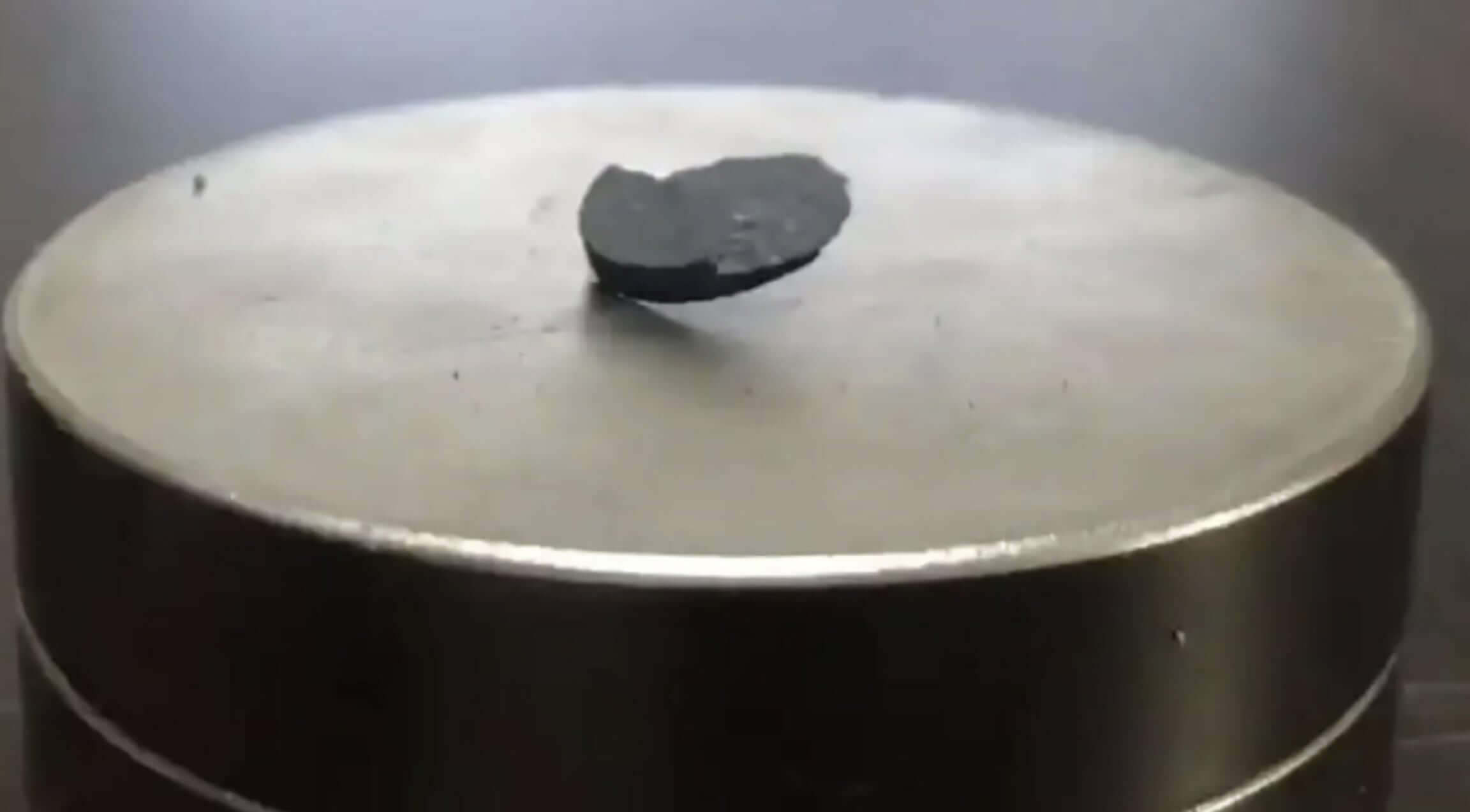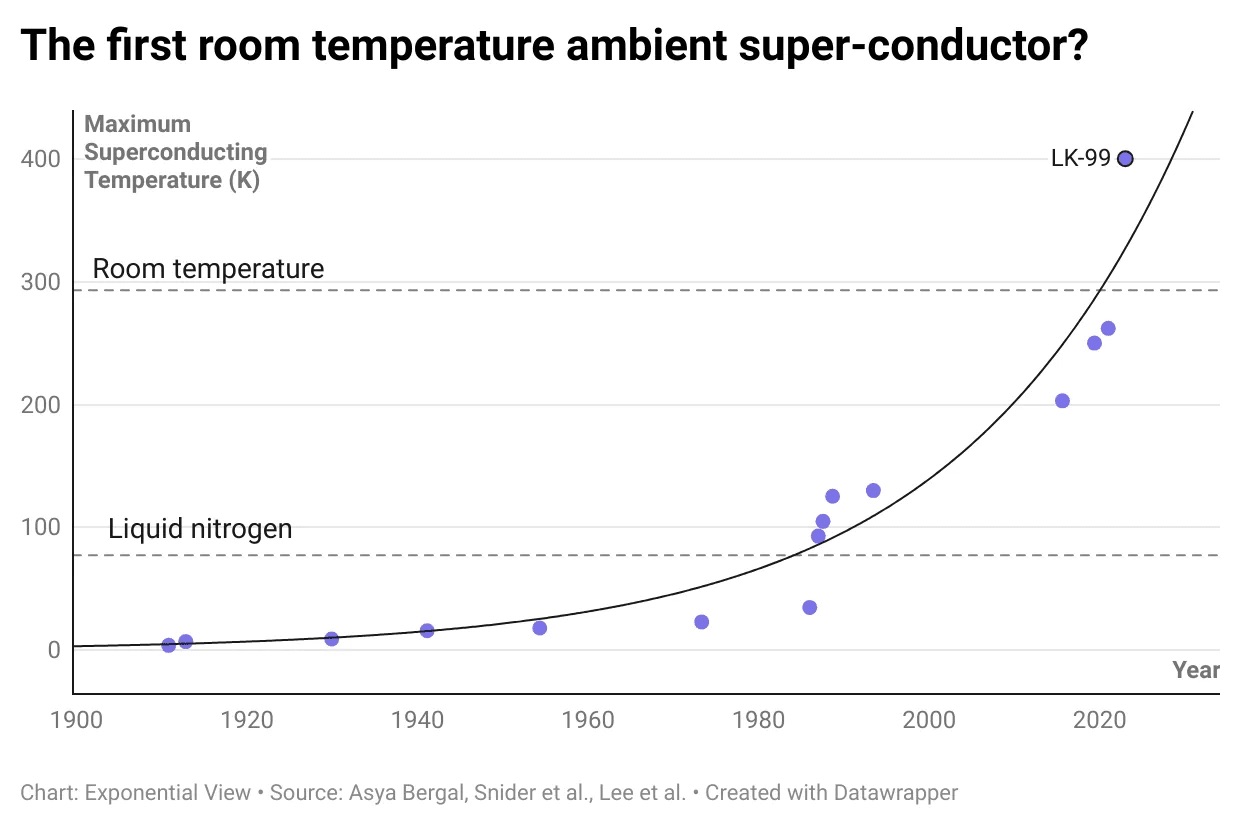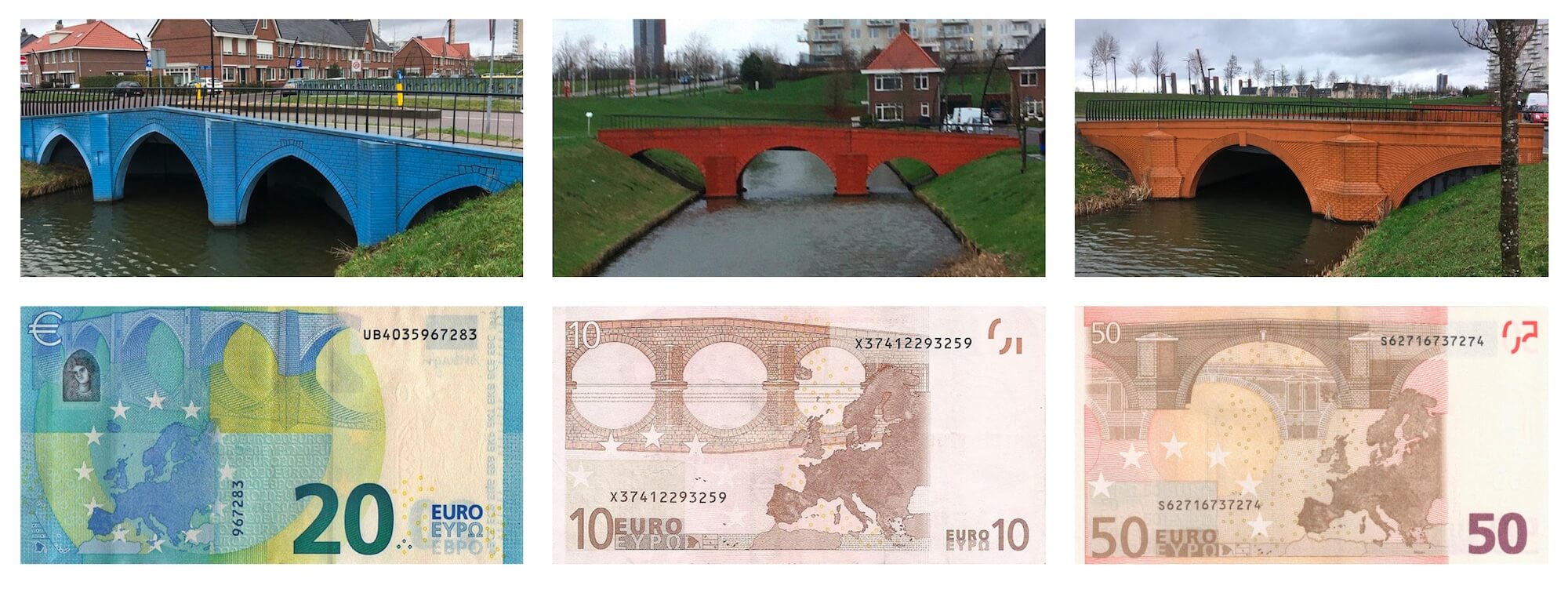Hi everyone!
Over the past two weeks, I’ve been following the news around LK-99 with great interest. It’s a potential room-temperature superconductor. I knew little about superconductors, so I went on a deep dive and read a ton of interesting articles/tweets.
I summarized my findings in this edition of the newsletter. I explain what superconductors are and how room-temperature superconductors would affect our world.
Feel free to skip this part if you aren’t interested. The newsletter also contains the regular sections with “interesting things I found on the internet” 😉
Take care,
Xavier
A primer on superconductors (and LK-99)
On 22 July 2023 a paper was published on arXiv by South Korean researchers claiming to have made a room-temperature, ambient-pressure superconductor. The scientific community was very skeptical of these claims, and up until today, labs around the world are trying to make their own LK-99 samples and test them.

What is a superconductor?
Let’s start with the basics: a superconductor is a material with zero electrical resistance and that expels magnetic fields. Let’s explain these properties.
-
Normally, when an electrical current passes through a material, it encounters resistance and heats up. This limits the amount of current you pass through a wire before it melts. Electric cars use thick copper cables because they charge with high currents which would melt through a thin wire.
-
A superconductor also expels magnetic fields. They levitate above magnets and stay completely still while floating. That's why you see scientist publish videos of LK-99 samples floating above magnets. Regular materials should not levitate above magnets and stay still.
Many materials have these properties, but they either need to be cooled down to extreme temperatures or put under enormous pressure. That makes them impractical and very expensive. You can't run an electrical grid on superconductors that require a constant flow of liquid nitrogen to be cooled.
High-temperature superconductor
Scientists have been looking for a high temperature superconductor for quite a while. Until 1986, physicist believed that superconductivity could only happen at temperatures near absolute zero (0K or -273°C). Later that year, they found materials that could super-conduct at higher temperatures (-181°C). So these were called "high-temperature" superconductors.
Room-temperature superconductors
Fast forward a couple of decades, and we've found superconductors that work at near room-temperature, but only while being under enormous pressure. That's a nice improvement, but not practical either.
So the holy grail of superconductors is finding one that works at room temperature, at ambient pressures. And the South Korean researchers claimed to have just done that.

Impact
As mentioned, the scientific community is very skeptical about LK-99. But let’s assume for a second that the claims are true and that LK-99 is a superconductor that works at room temperature and at ambient pressure. How would that affect our world? Here are a few examples:
-
Energy grids 🔌
Resistance in copper cables and transformers causes some energy to be lost as heat. Worldwide, about 5 to 10% of electrical energy is lost due to transmission. A room-temperature superconductor would eliminate these losses. -
Computer chips 💻
Processors and graphics cards kick out a lot of heat because of internal resistance. These have to be cooled with big heat sinks and fans in order to stay operational. A room-temperature superconductor would eliminate most of this heat output. Chips would use less energy, need less cooling, and be overall faster. That could lead to advancements in fields such as artificial intelligence. -
Medical imaging 🏥
MRI machines generate a very strong magnetic field by passing a lot of current through a superconductor. Currently, these superconductors are cooled with liquid helium, which is expensive and hard to work with. A room temperature superconductor could remove this complexity and make MRI machines easier and less expensive to operate. -
Electric motors 🚗
Every electric motor is nothing more than a copper coil wrapped around a permanent magnet. When an electrical current flows through the coil, it creates a magnetic field. This field reacts with the magnet, causing the coil to rotate. A coil made from a room-temperature superconductor would allow us to push more current through it, creating a more powerful motor. -
Magnetic levitation 🕴️
Maglev trains use liquid-cooled superconductors to levitate above the track. This allows them to travel at high speeds with very little friction. A room-temperature superconductor would make these trains way more practical to operate.
You get the gist. A superconductor like this would be revolutionary!
Is LK-99 the real deal?
And now the million dollar question: is LK-99 the breakthrough we've been looking for? That's unknown at this moment. Various labs tried recreating it with various levels of success. Some labs observed the magnetic levitation, while others didn't. Some have measured zero-resistance at low temperatures, while others measured high resistivity.
Whatever the case may be, it's very entertaining to follow these developments. Many labs are sharing live updates on Twitter or doing live streams on Twitch and YouTube. It's amazing to see the scientific method at work!
If you want to track the various replication efforts, have a look at the Wikipedia page for LK-99 or this post on the Spacebattles forum.
🤓 Cool Stuff I Found on the Internet
ChatGPT is losing users
In newsletter 28, I wrote about my struggles to integrate tools like ChatGPT into my daily workflow. Well, turns out I wasn't alone and people are losing interest in ChatGPT. Traffic to ChatGPT fell 10% in June. Seems like everyone is moving on from large language models and is now becoming an expert in superconductors instead 😉

Bridges on Euro banknotes are no longer fake
I was today years old when I found out that bridges on Euro banknotes aren’t based on real bridges. Instead, each bridge represents an architectural style from classical antiquity to modern 20th-century architecture. Dutch designer Robin Stam decided to actually build the bridges in Spijkenisse near Rotterdam. Before starting his project, he asked permission from the European Central Bank. He not only got permission but also a 1.3 million dollars grant!

The Boeing 767 that ran out of fuel mid-flight
This is the story about Air Canada Flight 143. Before take off, the fuel gauges didn’t work, and rather than grounding the plane, the pilot asked engineers to manually check fuel levels. They performed the check multiple times, and yet the plane ran out of fuel mid-flight. The Boeing 767 turned into a glider. Luckily, captain Pearson could slow down the plane using a “forward-slip manoeuvre” and land on an abandoned airstrip in Gimli. The cause of the incident? Boeing’s new 767 was using the metric system, while the documentation was in imperial units. Units are hard.
A subway system designed by engineers slime mold
How do you design the perfect railway system? Ask slime mold to do it for you! Scientists placed Physarum polycephalum in an environment that mimicked Tokyo. They placed oat flakes (a delicacy for molds) in places where there are stations and let the mold grow. At first, it grew evenly, but after a few hours, the mold refined its network of nutrient-transporting tunnels to make it more efficient. The result looks almost identical to Tokyo’s railway system. That's interesting, because mold has no brain or awareness of the overall problem. Yet, its “solution” is perfect. The hope is that this research could shed a light on how blood vessels grow to support tumors, which could lead to better cancer treatments.
Twitter's rebranding could be a trademark nightmare
Elon Musk is rebranding Twitter to X, and yes, it’s a bit of a mess at the moment. But things could get even worse. Both Microsoft and Meta (Facebook) own trademarks for “X”. Microsoft’s trademark is for gaming services, while Meta’s trademark is for “online forums” and “providing internet chat rooms”. This could get spicy! Musk also took over the handle @x from a user who held it since 2007. As compensation, they invited the user to the company’s HQ and offered some company swag.
The neuroscience of speed reading: it's bullshit
Researchers tested two common techniques of speed reading: using peripheral vision to reduce eye movement and silencing your inner reading voice. The first one doesn't work because your peripheral vision isn't sharp enough to read text. The second technique comes at the expense of comprehension as the researchers found that subvocalizing written text boosts your understanding of it. Their conclusion is simple: speed reading doesn't work. In order to read faster, read more. Practice makes perfect!
🧠🤖 Artificial intelligence
AI Turns QR Codes into Works of Art
Let’s face it, QR codes are boring and ugly. But thanks to stable diffusion, you can convert them into a piece of art! The results are stunning. I was doubtful that these QR codes would actually work, but the iOS camera app had no problem scanning them. Expect these to pop up in creative marketing materials soon.

👽 Space
NASA accidentally cuts contact with Voyager 2
Voyager 2 is almost 20 billion kilometers away from Earth and remains in contact with NASA. Last week, NASA send a series of “planned commands” to the craft, one which told the spacecraft to point its antenna 2 degrees away from Earth. The agency then lost all contact with Voyager. Luckily, NASA and JPL accounted for this possibility. The craft is programmed to reset its orientation multiple times per year, with the next one scheduled for October. And then a few days ago, NASA used multiple antennas to broadcast a powerful signal to Voyager, asking it to realign its antenna early. And it worked!! Full communications are restored.
Ingenuity back in action on Mars
NASA's Ingenuity helicopter on Mars went offline after it flew over a hill that blocked communication with the Perseverance rover. It took until the end of June for the rover to drive to a place where it could receive communications from the helicopter again. Ingenuity was designed to fly 5 times, but has now flown 52 times. The helicopter is used to scout the path ahead of Perseverance and guide it.

How Margaret Hamilton's Software Put Men on the Moon
Margaret Hamilton was a computer scientist who led the team that developed the software for the Apollo missions. She popularized the term “software engineering” and was responsible for making sure that the Apollo guidance computer was fault-tolerant. The computer could handle unknown problems and was flexible enough to interrupt a task for a more important one (which ended up being critical for the Apollo 11 moon landing)
🏥 Health & Medicine
CRISPR Could Be the Key to Alzheimer's Cure
55 million people are living with Alzheimer’s disease, which is caused by a buildup of beta amyloid protein in the brain. Over 70 genes are linked to the disease and since genetics is a factor, we should be able to “fix” it with gene editing techniques such as CRIPSR. Researchers used CRISPR to edit genes in mice that are linked to Alzheimer’s and the results were amazing: a 60% reduction in amyloid plaques and even restored cognitive abilities! These findings are very promising, but more research is needed. The next step is to translate the CRISPR treatment for humans, after which clinical trials can start.
Radiopharmaceuticals: highly localized cancer treatment
Traditional cancer treatments use a mix of surgery and radiation to remove and kill as many cancer cells as possible. Unfortunately, the radiation also kills healthy cells, which leads to fatigue and hair loss. Radiopharmaceuticals can change that. These drugs consist out of three parts: a targeting molecule that sticks to cancer cells, a radioactive isotope that kills cancer cells, and a linker that connects both together. The treatment delivers radiation precisely where needed, resulting in fewer healthy cells being killed in the process.
Cure for brittle diabetes now available in US
Brittle diabetes is a type of diabetes that is characterized by wildly fluctuating blood sugar levels. A new treatment for it is now available in the US. Insulin-secreting cells (called islets) are sourced from donated pancreases and transplanted into a person with brittle diabetes. These cells then produce the insulin needed to regulate blood sugar levels. It can minimize or even end the need for synthetic insulin. Some people don’t need any insulin for years! Despite its benefits, there are some drawbacks. It may not work for certain people, and taking immunosuppressants is necessary to prevent the body from rejecting the donated cells.
